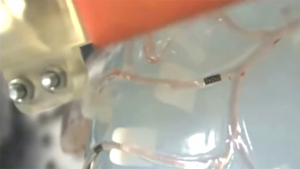Imagine needing surgery but the nearest surgeon is a day's drive. Or you need medical attention in a part of your body that physicians cannot easily access. A group of tiny squishy robots might soon be able to assist doctors—literally—reach patients.
In a medical breakthrough, engineers at the University of Hawaiʻi at Mānoa have developed microscopic soft robots that can work as a team inside the human body, opening new possibilities for minimally invasive procedures.

The new technology could allow doctors to guide several tiny, flexible robots independently through the body's complex network of tubes and vessels. This advancement could make it possible to deliver medicine to multiple locations, perform several tasks simultaneously during medical procedures and conduct procedures remotely.
"Living on islands means many of our residents have to travel long distances, sometimes even between islands, for specialized medical procedures, but these tiny robot swarms could eventually help us deliver advanced care more locally and less invasively," said study co-author and Department of Mechanical Engineering Assistant Professor Tianlu Wang. "This technology could be particularly valuable for our kūpuna and residents in remote areas who might otherwise need to make challenging trips to major medical centers for certain treatments."
The key innovation lies in how these robots interact differently with the surrounding tissue, allowing doctors to control each one separately using magnetic fields generated by a single external magnet. These robots can squeeze through tight spaces and adapt their shape to fit the body's natural pathways, similar to how an octopus can change its form to move through small openings.
'Cargo' delivery
Using medical imaging technology, researchers successfully demonstrated their system by navigating multiple robots through a complex artificial model of body vessels. The robots could deliver "cargo" to different locations and even modify fluid flow within these passages. This development could lead to more efficient and less invasive medical procedures, particularly in hard-to-reach areas of the body.
Instead of performing multiple procedures, doctors might eventually deploy several robots at once to accomplish various tasks simultaneously. The research team envisions this technology could be adapted for various types of miniature soft robots, opening new possibilities for medical treatments and diagnostic procedures in the near future.
The breakthrough research was an international collaboration between UH Mānoa, Max Planck Institute for Intelligent Systems in Germany, ETH Zurich in Switzerland, and Koç University in Turkey. It was published on November 6, in Science Advances .
The post Team of microscopic soft robots could transform medical care first appeared on University of Hawaiʻi System News .






